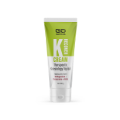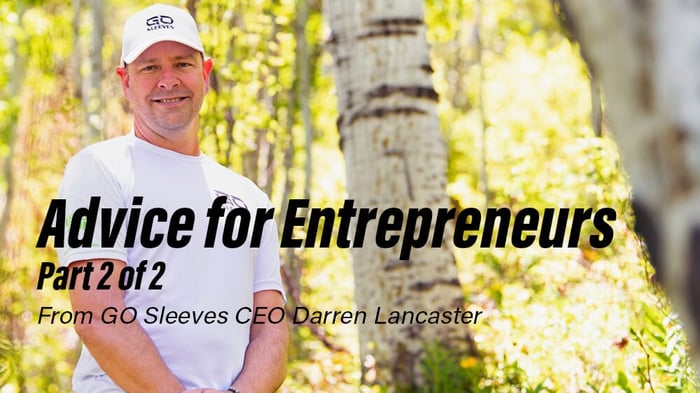Part 2: Six Tips for Startups
In this two-part blog, I’ll share the my advice for fellow entrepreneurs with some super practical startup tips.
Darren Lancaster, Co-founder, GO Sleeves
1. Don't do it on your own
First of all, fear is the enemy of moving forward. If you’ve got an idea, take incremental steps forward, and don’t fear what you don’t know. We’re not meant to build businesses by ourselves. We don’t have the skills to do it and we wouldn’t enjoy it that much. Needing help isn't a weakness. It’s amazing how far people will push themselves. It can be especially hard when you feel like you’re at your lowest, but that’s when you need help the most.
It’s all about who you have in your network who might have some interest to help you untangle your idea. Pull-on one thread at a time. A lot of the time, people want to avoid the tougher problems instead of taking them on. Get some expertise around you to help, it starts to reduce the fear.
2. Know your customers
There’s no real formula to determine which idea will or won’t be a winner – it’s more of a culture and a mindset of incremental experimentation. Slowly, but surely that minefield of everything that could go wrong starts to get smaller and smaller. One of the most important things to prioritize is experience with real users. Don’t be afraid of the secret getting out. The odds of someone else doing your idea before you are much lower than your odds of losing because you launched something that isn’t right because you didn’t work with customers or users to learn.
You might have a ton of confidence because you think a product will work, but do you know what your users like, which of their needs it solves, and exactly how they’ll talk about it? Do you know how you’re going to convey to them what your idea is about? You won’t know any of that until you actually go live with them. That’s the whole concept of a Minimum Viable Product. (MVP – the bare minimum of what you need to build and invest – see “Lean Startup for more background”). Get the minimum built and get it out there and start to learn as quickly as you can.
3. Be open to killing it early
So you have a great idea. You’re ready to put in the endless hours turning it into a business. You might even have funding lined up. So what now?
Here are some of the early questions I ask myself:
In terms of patents, is the idea a defensible space? Is it at least a billion-dollar market cap space? If I do happen to find success against the odds, is it a space that’s big enough to be meaningful? You can’t always predict if people will want something, but you can figure out if you are able to produce it.
Next, I need to know if the economics seem reasonably okay and that there’s enough margin for it to be a viable business. On the other hand, there’s only so far you can go. Eventually, you have to start taking experimental, incremental steps. As you’re taking these steps forward, you can be open to the idea that if you get negative data – finding out sooner is always better. Don’t be afraid to kill a pursuit before you invest too much into it – that’s a good thing.
4. The most important thing I've learned
Even when you get to a point you know you’ve got a product with market-customer fit… Even when you have the validation of an MVP... Even when you’re just able to get that MVP in the game and start learning… You can get there and still not know what the business is meant to do or be.
Most investors and stakeholders expect entrepreneurs to have 5-year plans and omnipotence, but it’s just not possible. It’s like birthing a baby and declaring on day one that this kid is going to become a doctor. As crazy as that sounds, that’s the anticipation or expectation that is put on businesses by the institutional money that’s put into these things.
I’ve had to live by those constraints and I’ve seen what it does – and it can really put a limit on what businesses actually can do. Expectations are high, but the realities aren’t always going to be on that trajectory. It’s gonna be something else.
We’ve had the luxury with GO Sleeves to have a pretty tightly held little group who gets to decide incrementally what the business is meant to be when it grows up.
5. How should someone start marketing a new product
In my personal experiences, I’ve never had enough cash for a “Spray and Pray” approach to marketing. You’ve seen those products that have “As Seen on TV” advertising. That strategy comes from companies who rarely ever create the idea of the product. They just see something that might have a possibility of working. They make a deal with the entrepreneur to give them two cents of every dollar made. They promise a small slice of something big – which is always better than a big slice of nothing. The product gets thrown in retail stores with a massive budget that can be tested for TV advertising. They have a recipe and it works. Most of us don’t have that kind of money to throw around.
I’ve had to use cost-effective learning mechanisms which are a mix of online and offline approaches. (See Part 1)
6. My best advice? Learn marketing
Learn how to connect with people. At least learn enough to know how to plug in people who really know marketing and let them loose.
When it comes down to it, we’re not in charge of what we build. You don’t get to control your brand. It has its own life. It’s in the hearts and minds of your customers. All you can do is try to nurture and condition positive reactions and emotions in your customers. That can be tough for people who have a technical background or are used to having full control of things. Not a lot of entrepreneurs are out there figuring out how to build relationships with their customers – it’s really something you should know how to do.
READ PART 1 – HOW GO SLEEVES GOT MOVING
If you want to go deeper into my recommendations, check out my interview with Rob Elliott on his “Real Journeys of Success” podcast on Spotify or YouTube.
Darren Lancaster is a serial entrepreneur with the ability to quickly and cost-effectively validate a product and offer concepts in the global digital marketplace, followed by scaling up winners faster than competitors.
Darren has previously:
- Co-founded and built a direct-to-consumer brand, ThinOptics, from the ground up to the top-selling reading glasses product in the domestic US market in under 5 years.
- Co-founded a wireless internet technology and services company, Rooftop Communications, which was acquired by Nokia for $57M USD.
- Co-invented an innovative Interactive Email solution offered by GroupVine which is being used to dramatically improve email marketing results for B2C and B2B brands.











